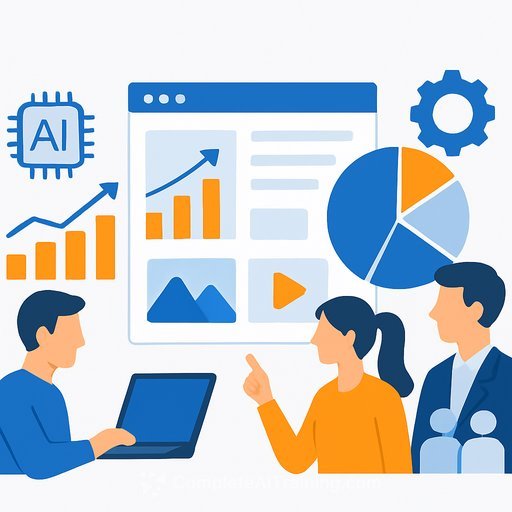MarketingOps is redefining success for the age of AI
Marketing operations isn't a backstage role anymore. It's the engine room that turns messy goals into scalable systems - with fewer resources, higher expectations and tighter timelines.
At MOps-Apalooza 2025, one theme cut through the noise: success in MOps has shifted. It's less about producing pipeline on command and more about enabling the entire go-to-market machine to ship faster, smarter and with less waste.
The new success metric: enablement and scalability
For the first time, the top measure of MOps success has moved from direct pipeline to operational enablement and scale. Translation: how well you help GTM teams get ROI from the stack and execute at speed.
This reframes the job. You're not the short-order chef for campaign requests - you're the systems architect who makes growth repeatable.
- Measure what matters: time-to-launch, adoption and usage by team, data quality scores, SLA compliance, incident rate, and cost per workflow.
- Build once, ship many: templates, playbooks and reusable components that reduce one-off work.
- Kill hidden toil: document processes, retire low-value automations and standardize requests with clear intake and SLAs.
AI: expectation, not experiment
AI isn't the pilot project anymore; it's table stakes. As one leader put it, tech is moving faster than strategy - which means the teams that win are the ones who set guardrails and get specific about use cases.
AI can see patterns and ship drafts at speed. It cannot read organizational nuance, unwritten rules or the messy context of your stack. Human judgment still makes the call.
- High-fit AI uses: webinar ops, internal docs, QA checks, data hygiene, enrichment, email QA, recurring reports.
- Keep human-owned: core messaging, positioning, campaign strategy, creative direction and anything brand-defining.
- Guardrails: approved prompts, human-in-the-loop review, privacy constraints, brand voice checks and clear "no-go" zones.
Or as one speaker put it: "AI doesn't replace people - it replaces the processes that slow them down." If your workflows are well-defined, AI removes friction. If they're chaotic, it amplifies the chaos.
For perspective on adoption trends and ROI ranges, see recent AI research from McKinsey.
More scale, more noise (and what to do about it)
Cold outreach is getting squeezed. Engagement rates that were ~15% in 2018 have slid to ~3% today. With inboxes flooded by near-identical messages, "more volume" is no longer a strategy.
- Prioritize signal: route by intent, fit and recency. Pair first-party engagement with verified third-party intent.
- Shorten feedback loops: test smaller, measure faster, kill faster. Weekly learnings over quarterly rollups.
- Strengthen voice: keep brand tone, relevance and specificity. AI can draft, you decide what sounds human.
- Blend teams: integrate SDRs into lifecycle programs and post-opportunity nurture - not just top-of-funnel volume.
Close the C-suite gap: translate ops to impact
Executives care about outcomes. They don't need every workflow detail - they need clarity on how your systems move revenue, margin and risk.
- Story, not specs: one slide each: the problem (friction or cost), the intervention (system/process), the outcome (speed, savings, revenue lift).
- Ladder the metrics: operational metric → commercial metric → business metric. Example: time-to-launch ↓ 40% → campaigns per quarter ↑ 2x → pipeline efficiency ↑.
- Show the cost of delay: quantify waste from manual work, error rates and rework. Make inaction expensive.
The community advantage
MOps work is context-heavy. You don't copy-paste your way to excellence - you compare notes, adapt and refine. That's why events like MOps-Apalooza matter.
As tech accelerates, creativity and systems thinking become your edge. The consensus was simple: AI won't make the hard decisions for you. It can help you make them faster - if your foundation is sound.
30-60-90: a practical plan
- 30 days: audit requests, SLAs, tool usage and data quality. Identify top 5 bottlenecks and hidden toil.
- 60 days: ship a reusable campaign template, standardize intake, and pilot AI on one repetitive workflow with human review.
- 90 days: publish an enablement scorecard (time-to-launch, adoption, incident rate, cost per workflow) and present two "ops-to-impact" win stories to leadership.
What this means for MOps leaders
Your value is in reducing friction at scale. Build systems that compound, make AI remove drudgery, and translate your work in business terms. That's how MOps leads - not by doing more, but by enabling more to get done.
If you're formalizing prompts, review loops and AI guardrails for marketing, explore focused upskilling for your team: AI Certification for Marketing Specialists. For hands-on prompt frameworks and patterns, see our prompt engineering resources.
As two leaders put it on stage: "AI doesn't change the game. MOps does. We don't adopt the future. We design it. And this community is doing it together."
Your membership also unlocks:






